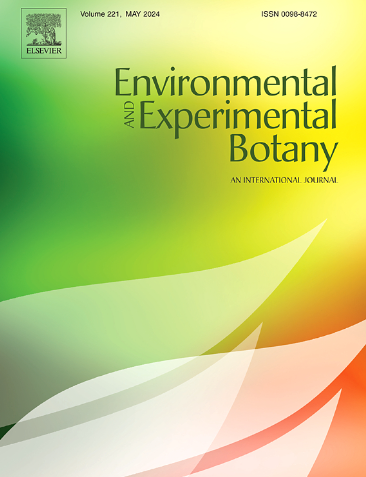气孔密度不同的小麦基因型对热和干旱联合胁迫的叶气体交换反应
IF 4.5
2区 生物学
Q2 ENVIRONMENTAL SCIENCES
引用次数: 0
摘要
气孔调节植物的气体交换和水分平衡,其密度可能是非生物胁迫响应的关键因素。本研究的目的是研究三种气孔密度不同的春小麦基因型的叶片气体交换对渐进干旱和热旱联合胁迫的响应。气孔导度(gs)是最敏感的参数,随着干旱胁迫的加剧而下降。这对蒸腾作用和叶片冷却产生了负面影响,并在 gs 下降到 550 mmol m-2 s-1 时限制了光合作用(A)。随着时间的推移,处理对三种基因型的影响相似,与气孔密度无关。然而,当干旱胁迫中加入热量时,如果与盆中可渗透土壤水分(FTSW)有关,气孔密度低和气孔密度高的栽培品种的 gs 和 A 反应不同。高气孔密度栽培品种在 FTSW > 0.3 时的最大 gs 没有差异,而在 FTSW < 0.3 时,在单独干旱和干旱与高温共同胁迫下,gs 和 A 的降幅相似。低气孔密度栽培品种在高温和干旱联合胁迫下表现出更高的最大气孔密度和最严重的气孔密度下降,而在单独干旱胁迫下气孔密度下降速度明显较慢,这也反映在干旱胁迫下A的下降速度明显慢于联合胁迫。总体而言,无论气孔密度如何,气孔关闭的干旱响应在高温和干旱同时胁迫下的生理响应中占主导地位,只有在联合胁迫下,最大光化学效率 Fv/Fm 才会受到负面影响。总之,要阐明干旱以及旱热并存对不同气孔密度小麦品种叶片气体交换的影响,关键是要将参数与可用土壤水而不是干旱持续时间联系起来。本文章由计算机程序翻译,如有差异,请以英文原文为准。
Leaf gas exchange responses to combined heat and drought stress in wheat genotypes with varied stomatal density
Stomata regulate the plant’s gas exchange and water balance, and their density may be a crucial factor in the response to abiotic stresses. The aim of this study was to investigate the response of leaf gas exchange of three spring wheat genotypes with different stomatal density to progressive drought and combined heat and drought stress. The stomatal conductance (gs) was the most sensitive parameter that declined with increasing drought stress. This negatively affected transpiration and leaf cooling, and limited photosynthesis (A) when gs decreased to < 550 mmol m−2 s−1. The treatments affected all three genotypes similarly over time irrespective of stomatal density. However, when related to the fraction of transpirable soil water (FTSW) in the pot, gs and A of the low and high stomatal density cultivars responded differently when heat was added to the drought stress. The high stomatal density cultivar showed no difference in maximum gs at FTSW > 0.3, and a similar decline of gs and A at FTSW < 0.3 in drought alone and combined drought and heat. The low stomatal density cultivar showed a higher maximum gs and the most severe decline of gs under combined heat and drought stress and a significantly slower decline of gs under drought alone, which was also reflected in a significantly slower reduction in A under drought compared to the combined stress. Overall, the drought response of stomatal closure dominated the physiological response under simultaneous heat and drought irrespective of stomatal density, and it was only in the combined stress that the maximum photochemical efficiency Fv/Fm was negatively affected. In conclusion, to elucidate the effect of drought and combined drought and heat on the leaf gas exchange in wheat cultivars with varied stomatal density, it is crucial to relate the parameters to the available soil water, not the duration of the drought.
求助全文
通过发布文献求助,成功后即可免费获取论文全文。
去求助
来源期刊

Environmental and Experimental Botany
环境科学-环境科学
CiteScore
9.30
自引率
5.30%
发文量
342
审稿时长
26 days
期刊介绍:
Environmental and Experimental Botany (EEB) publishes research papers on the physical, chemical, biological, molecular mechanisms and processes involved in the responses of plants to their environment.
In addition to research papers, the journal includes review articles. Submission is in agreement with the Editors-in-Chief.
The Journal also publishes special issues which are built by invited guest editors and are related to the main themes of EEB.
The areas covered by the Journal include:
(1) Responses of plants to heavy metals and pollutants
(2) Plant/water interactions (salinity, drought, flooding)
(3) Responses of plants to radiations ranging from UV-B to infrared
(4) Plant/atmosphere relations (ozone, CO2 , temperature)
(5) Global change impacts on plant ecophysiology
(6) Biotic interactions involving environmental factors.
 求助内容:
求助内容: 应助结果提醒方式:
应助结果提醒方式:


